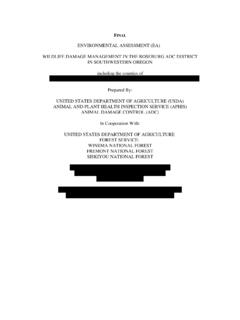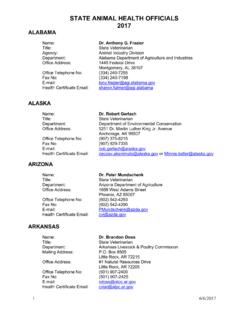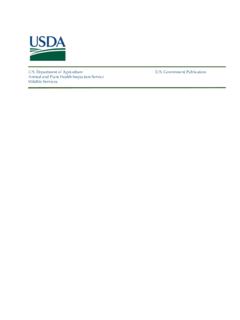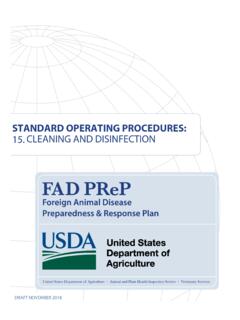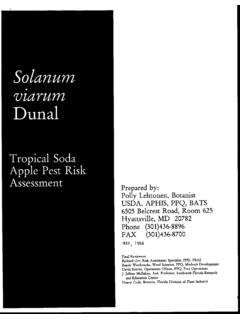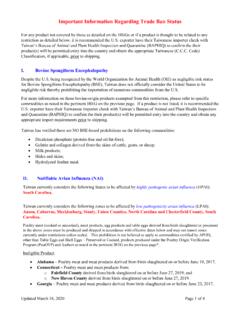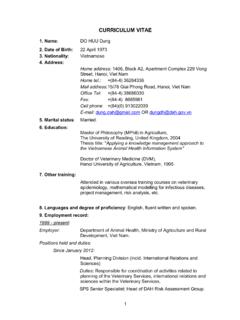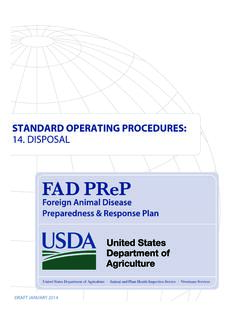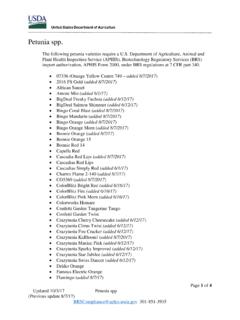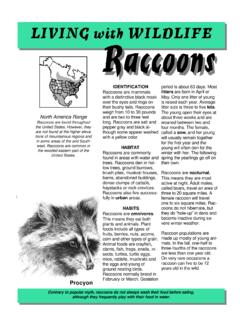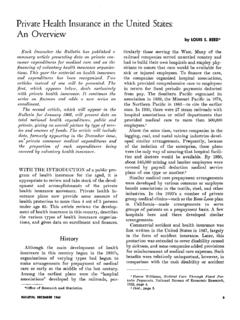Transcription of Facts About Brucellosis - USDA
1 1 Facts About Brucellosis 1. What is Brucellosis ? It is a contagious, costly disease of ruminant ( cattle, bison and cervids) animals that also affects humans. Although Brucellosis can attack other animals, its main threat is to cattle, bison, cervids ( elk and deer), and swine. The disease is also known as contagious abortion or Bang's disease. In humans, it's known as undulant fever because of the severe intermittent fever accompanying human infection or Malta fever because it was first recognized as a human disease on the island of Malta. 2. How serious is Brucellosis ? Bovine Brucellosis is a serious disease of livestock that has significant animal health, public health, and international trade consequences.
2 Considering the damage done by the infection in animals decreased milk production, weight loss, loss of young, infertility and lameness this disease is a formidable threat to livestock. The fact that this disease can spread rapidly and be transmitted to humans makes it all the more serious. 3. What disease agents cause Brucellosis ? The disease is caused by a group of bacteria known scientifically as the genus Brucella. Three species of Brucella cause the most concern: B. abortus, principally affecting cattle, bison and cervids; B. suis, principally affecting swine and reindeer but also cattle and bison; and B. melitensis, principally affecting goats but not present in the united states .
3 In cattle and bison, the disease primarily localizes in the reproductive organs and/or the udder. Bacteria are shed in milk or via the aborted fetus, afterbirth, or other reproductive tract discharges. 4. What are the signs of Brucellosis ? There is no effective way to detect infected animals by their appearance. The most obvious signs in pregnant animals are abortion or birth of weak calves. Milk production may be reduced from changes in the normal lactation period caused by abortions and delayed conceptions. Not all infected cows abort, but those that do usually abort between the fifth and seventh month of pregnancy. Infected cows usually abort once, but a percentage will abort during additional pregnancies, and calves born from later pregnancies may be weak and unhealthy.
4 Calves from infected cows may have latent infections, infections that are not detected until they become pregnant, abort or give birth. Even though their calves may appear healthy, infected cows continue to harbor and discharge infectious organisms and should be regarded as dangerous sources of the disease. Other signs of Brucellosis include an apparent lowering of fertility with poor conception rates, retained afterbirths with resulting uterine infections, and (occasionally) enlarged, arthritic joints. 5. How is Brucellosis spread? Brucellosis is commonly transmitted to susceptible animals by direct contact with infected animals or with an environment that has been contaminated with discharges from infected 2 animals.
5 Aborted fetuses, placental membranes or fluids, and other vaginal discharges present after an infected animal has aborted or calved are all highly contaminated with infectious Brucella organisms. Cows may lick those materials or the genital area of other cows or ingest feed or water contaminated with the disease-causing organisms. Despite occasional exceptions, the general rule is that Brucellosis is carried from one herd to another by an infected or exposed animal. This mode of transmission occurs when a herd owner buys replacement cattle or domestic bison that are infected or have been exposed to infected animals, animal tissues or animal discharges prior to purchase.
6 The disease may also be spread when wild animals or animals from an affected herd mingle with Brucellosis -free herds. 6. What is the incubation period of Brucellosis ? An incubation period is the interval of time between exposure to an infectious dose of organism and the first appearance of disease signs. The incubation period of Brucellosis in cattle, bison, and other animals is quite variable ranging from About 2 weeks to 1 year and even longer in certain instances. When abortion is the first sign observed, the minimum incubation period is usually About 30 days. Some animals abort before developing a positive reaction to the diagnostic test.
7 Other infected animals may never abort. Generally, infected animals that do not abort develop a positive reaction to the diagnostic test within 30 to 60 days after infection, although some may not develop a positive reaction for several months to over a year. 7. Can Brucellosis in animals be cured? No. Repeated attempts to develop a cure for Brucellosis in animals have failed. Occasionally, animals may recover after a period of time. More commonly, however, only the signs disappear and the animals remain diseased. Such animals are dangerous sources of infection for other animals with which they associate. 8. Can Brucellosis be avoided?
8 Yes. Brucellosis may be avoided by using proper sanitation methods. Proper herd management strategies can also aid in the avoidance of the disease. These include: Maintaining closed herds, recording individual animal identification and maintaining accurate records, isolating and testing purchased additions as well as cattle re-entering the herd and arranging diagnostic workups and necropsies for potentially or suspected Brucellosis infected cattle. 9. Is there a program to eradicate Brucellosis ? Yes. In 1954 Congressional funds were first approved for a Cooperative State - Federal Brucellosis Eradication Program to eliminate the disease from the country.
9 Like other animal disease eradication efforts, success of the program depends on the support and participation of livestock producers. The basic approach has always been to vaccinate calves, test cattle and domestic bison for infection, and send infected animals to slaughter. Depopulation of herds, if funds are available, may be used if herds are severely affected. Identification of market animals for tracing, surveillance to find infected animals, investigation of affected herds, and vaccination of replacement calves in Brucellosis -affected areas are important features of the current program. The program's Uniform Methods and Rules set forth the minimum standards for states to achieve eradication.
10 states are designated Brucellosis free when none of their cattle or bison is found to be infected for 12 consecutive months under an active surveillance program. For current Brucellosis State classifications see the updates posted at: 3 and 10. How effective is the Brucellosis Eradication Program? At the beginning of the program, Brucellosis was widespread throughout livestock, but eradication efforts have had dramatic results. In 1956, there were 124,000 affected herds found by testing in the united states . By 1992, this number had dropped to 700 herds and the number of affected, domestic herds has declined to single digits since then.
